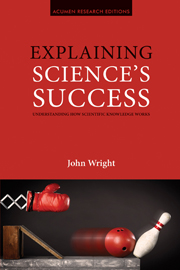Book contents
- Frontmatter
- Contents
- 1 Some surprising phenomena
- 2 Some unsatisfactory explanations of the phenomena
- 3 A defeasible a priori justification of induction
- 4 The independence of theory from data
- 5 Some more success-conducive properties of theories
- 6 Newton's laws of motion and law of gravitation
- 7 Special relativity
- 8 Mendelian genetics
- 9 Conclusion
- Notes
- Bibliography
- Index
8 - Mendelian genetics
- Frontmatter
- Contents
- 1 Some surprising phenomena
- 2 Some unsatisfactory explanations of the phenomena
- 3 A defeasible a priori justification of induction
- 4 The independence of theory from data
- 5 Some more success-conducive properties of theories
- 6 Newton's laws of motion and law of gravitation
- 7 Special relativity
- 8 Mendelian genetics
- 9 Conclusion
- Notes
- Bibliography
- Index
Summary
In the previous two chapters, we were concerned with applying the ideas developed in the bulk of this book to cases from the history of science. In Chapter 6 we considered Newton's arguments for his laws of motion and his theory of gravitation. In Chapter 7 we examined Einstein's arguments for special relativity. Of course, both these chapters took as their subject matter examples from physics. It is therefore natural to wonder whether the point of view developed here applies to sciences other than physics. Perhaps the most obvious non-physical science to look to is chemistry. I have elsewhere argued that the notion of the independence of theory from data can account for the transition from the phlogiston theory of Cavendish to the oxygen theory of Lavoisier (Wright 1991). Consequently, rather than consider here another example from chemistry, we consider a case from the biological sciences, specifically Mendel's development of genetics.
THE PHENOMENA MENDEL WAS CONCERNED TO EXPLAIN
We may identify four phenomena that were available to Mendel when he developed his theories. These were:
Phenomenon A The existence of “pure breeds”. It was known in Mendel's day that not all plants or animals that looked the same would necessarily have the same type of offspring. We can imagine two classes of plants P1 and P2 that all looked exactly the same, both in the sense that every member of P1 looked exactly the same as every other member of P1 and every member of P2 looked exactly the same as every other member of P2 and also in the sense that every member of P1 looked exactly like every member of P2. But Mendel knew that, despite the fact that every member of the two classes looked exactly like every other member, the two classes may still produce very different offspring. Suppose new generations of plants are produced by fertilizing members of P1 only with other members of P1 and fertilizing members of P2 only with other members of P2.…
- Type
- Chapter
- Information
- Explaining Science's SuccessUnderstanding How Scientific Knowledge Works, pp. 162 - 174Publisher: Acumen PublishingPrint publication year: 2012



